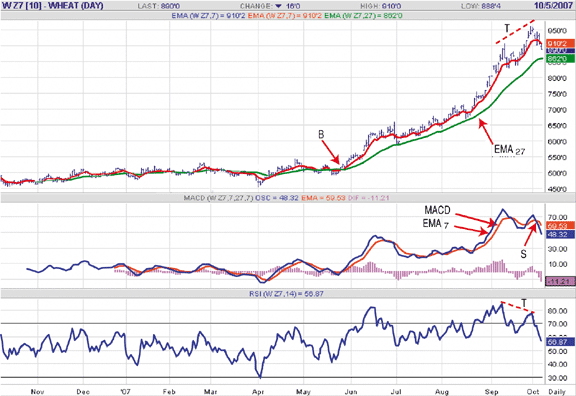Using Three In One
Three Common Tools, One Protocol
by Charles K. Langford, PhD
Three common tools of technical analysis can work together to generate continuous profits.
Common technical tools can be used together to generate a steady profit flow by using a single protocol. To examine how this can be done, the price action is divided into three time sequences: exhaustion of a trend, advent, and birth of the new trend. Among the dozens of tools available in technical analysis, three represent this method in a simple way: relative strength index (RSI), moving average convergence/divergence (MACD), and exponential moving average (EMA). Used correctly, these three tools can generate continuous profits.
Here's an example using the wheat market. Figure 1 is of the December 2007 CBOT contract. The daily bar chart shows two EMAs (seven and 27 periods); the MACD (7, 27, 7), which I find to work more efficiently than the usual 12, 26, 9; and the 14-period RSI.
BIRTH AND DEATH OF THE UPTREND
An uptrend is born when the two Emas give a buy signal. The signal occurs as the EMA(7) crosses above the EMA(27). After several attempts, on May 25, 2007, the EMA(7) crossed above the EMA(27). The price at the close was 525'0 cents. This was the birth of an uptrend, and as time elapsed, it accelerated -- that is, the EMA(27) became more convex. We had a first peak at 907'0 on September 12, 2007, when the RSI was at 84.18. A second, and the last in the chart, was at 961'6 on September 28, when the RSI was at 76.20.

FIGURE 1: THE PROTOCOL AT WORK. Here you see how the exponential moving averages, the relative strength index, and the moving average convergence/divergence when used together can signal the direction of a trend....Continued in the September issue of Technical Analysis of STOCKS & COMMODITIES
Excerpted from an article originally published in the September 2008 issue of Technical Analysis of STOCKS & COMMODITIES magazine. All rights reserved. © Copyright
2008, Technical Analysis, Inc.
Return to September 2008 Contents